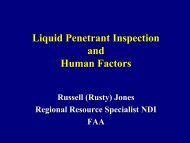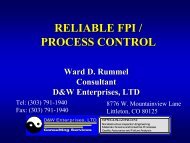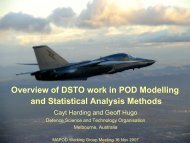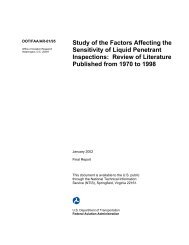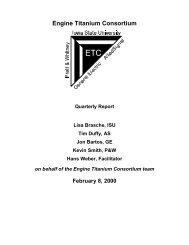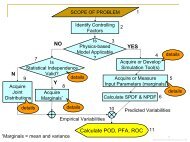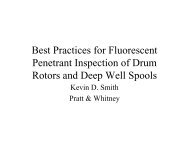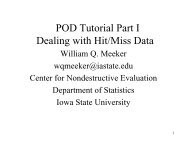Engine Titanium Consortium - Center for Nondestructive Evaluation ...
Engine Titanium Consortium - Center for Nondestructive Evaluation ...
Engine Titanium Consortium - Center for Nondestructive Evaluation ...
You also want an ePaper? Increase the reach of your titles
YUMPU automatically turns print PDFs into web optimized ePapers that Google loves.
• To provide the aircraft engine industry with meaningful assessments of the improvements in<br />
flaw detectability af<strong>for</strong>ded by the ETC inspection developments.<br />
Approach:<br />
The proposed program consists of six major elements, which have been selected in response to the<br />
issues identified above.<br />
Method to Tune Flaw Response Model to the Behavior of Naturally Occurring Flaws: A standard<br />
approach <strong>for</strong> readjusting parameters of the ultrasonic response model to incorporate in<strong>for</strong>mation<br />
about distributions of properties of naturally-occurring flaws will be developed. The advanced flaw<br />
response models that have been developed as a part of ETC-Phase I treat the case of flaws large<br />
with respect to the ultrasonic beam which may not be centered on the beam axis. Procedures to<br />
“tune” the model are now needed, in a fashion analogous to that employed in the R e technique, but<br />
taking advantage of the much greater capabilities of the ISU flaw response models to treat realistic<br />
flaw geometries. During the first four months of the program, team members will jointly develop a<br />
recommended approach to this end. One candidate approach will be to modify the R e method by<br />
replacing the assumed FBH reflector with a cylindrical reflector viewed from the side. The response<br />
of such reflectors is readily treated by the new ISU models and it more closely mimics the overall<br />
shape of naturally occurring hard-alpha inclusions.<br />
Assessment of Success of the new POD/PFA Methodology: The capability of the new<br />
methodology, incorporating ISU flaw response models <strong>for</strong> generating POD and PFA estimates, and<br />
<strong>for</strong> predicting the effects on POD and PFA of many individual inspection parameters, has already<br />
been established qualitatively and quantitatively, using synthetic flaws in test blocks of simple<br />
shape. The Random Defect Block (RDB) will provide a similar test. It was designed to ensure an<br />
adequate distribution of SHA properties to provide meaningful tests of the capability of both<br />
conventional and Multizone inspection systems, while allowing <strong>for</strong> sufficient randomization of the<br />
final choice of SHA parameters (such as length, diameter, percentage nitrogen, skew relative to the<br />
billet axis, and depth below the inspection surface) to avoid an inspector discerning any pattern to<br />
the design. Inspection results (e.g., amplitude, SNR) will be compared with response ranges<br />
predicted from the ISU model to validate the adequacy of the flaw and noise response models to<br />
predict actual experimental data and hence, drive the methodology. A final stage in the validation<br />
process will be a test of the ability of the ISU model to predict the ultrasonic response from the<br />
complex-shaped natural flaws found during the CBS. The results will be analyzed by the team as a<br />
final validation of the Phase I methodology and any necessary modifications will be made. Ef<strong>for</strong>ts<br />
to assess the success of the new methodology will continue through its direct application in other<br />
Phase II work elements.<br />
Improvements and Transfer to the OEMs of the POD/PFA Methodology and Software: For the new<br />
methodology to have full impact on damage tolerant design and management of rotating<br />
components, it is necessary that the tools, i.e., software be in a <strong>for</strong>m readily usable by the OEMs.<br />
These tools will be provided in Phase II. The methodology will be revised as needed based on<br />
results obtained in its application and software will be delivered to the OEMs incorporating those<br />
modifications. As dictated by the results of the RDB and CBS studies, any necessary refinements<br />
will be made in the flaw and noise response models. Included will be the development of numerical<br />
approximations to the predictions of the ultrasonic response models suitable <strong>for</strong> incorporation into<br />
Quarterly Report – January 1, 2002 –March 31, 2002<br />
print date/time: 6/6/2002 - 8:39 AM – Page 87



